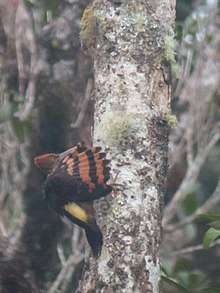Orange-backed woodpecker
The orange-backed woodpecker (Reinwardtipicus validus) is a bird in the woodpecker family Picidae. It is found in southern Thailand, Malaya, Sarawak and Sabah in Malaysia, Brunei, Sumatra and Java. It is placed in its own monotypic genus Reinwardtipicus.
| Orange-backed woodpecker | |
|---|---|
 | |
| Scientific classification | |
| Kingdom: | Animalia |
| Phylum: | Chordata |
| Class: | Aves |
| Order: | Piciformes |
| Family: | Picidae |
| Genus: | Reinwardtipicus Bonaparte, 1854 |
| Species: | R. validus |
| Binomial name | |
| Reinwardtipicus validus (Temminck, 1825) | |
| Synonyms | |
|
Chrysocolaptes validus | |
Taxonomy
The orange-backed woodpecker was described and illustrated in 1825 by the Dutch zoologist Coenraad Jacob Temminck in his Nouveau recueil de planches coloriées d'oiseaux from specimens that had been collected on the Indonesian island of Java. He coined the binomial name Pic validus.[2] The woodpecker is now the sole species placed in the genus Reinwardtipicus that was erected in 1854 by the French naturalist Charles Lucien Bonaparte to accommodate the orange-backed woodpecker.[3][4] The genus name Reinwardtipicus was chosen to honour the Dutch naturalist Caspar Reinwardt. His name is combined with picus, the Latin word for a woodpecker. The specific epithet validus is a Latin word meaning "strong" or "powerful".[5] The orange-backed woodpecker belongs to the tribe Campephilini in the subfamily Picinae. Molecular genetic studies have show that the species is closely related to the woodpeckers in the genus Chrysocolaptes.[6]
Two subspecies are recognised:[4]
- R. v. xanthopygius (Finsch, 1905) – Malay Peninsula, Sumatra and Borneo
- R. v. validus (Temminck, 1825) – Java
References
- BirdLife International (2012). "Chrysocolaptes validus". IUCN Red List of Threatened Species. 2012. Retrieved 26 November 2013.CS1 maint: ref=harv (link)
- Temminck, Coenraad Jacob (1838) [1825]. Nouveau recueil de planches coloriées d'oiseaux, pour servir de suite et de complément aux planches enluminées de Buffon (in French). Volume 4. Paris: F.G. Levrault. Plates 378 (male), 402 (female). The pages are not numbered. The 5 volumes were originally issued in 102 parts, 1820-1839
- Bonaparte, Charles Lucien (1854). "Quadro dei volucri zigodattili ossia passeri a piedi scansori". In de Luca, Serafino; Müller, D. (eds.). L'Ateneo Italiano; raccolta di documenti e memorie relative al progresso delle scienze fisiche (in Italian). Volume 2. Parigi [Paris]: Victor Masson. pp. 116-129 [122].
- Gill, Frank; Donsker, David; Rasmussen, Pamela, eds. (2020). "Woodpeckers". IOC World Bird List Version 10.1. International Ornithologists' Union. Retrieved 24 May 2020.
- Jobling, James A. (2010). The Helm Dictionary of Scientific Bird Names. London: Christopher Helm. pp. 306, 332, 398. ISBN 978-1-4081-2501-4.
- Shakya, S.B.; Fuchs, J.; Pons, J.M.; Sheldon, F.H. (2017). "Tapping the woodpecker tree for evolutionary insight". Molecular Phylogenetics and Evolution. 116: 182–191. doi:10.1016/j.ympev.2017.09.005.
External links
| Wikimedia Commons has media related to Reinwardtipicus validus. |
| Wikispecies has information related to Reinwardtipicus validus |
- BirdLife species factsheet for Chrysocolaptes validus
- "Reinwardtipicus validus". Avibase.

- "Orange-backed woodpecker media". Internet Bird Collection.
- Interactive range map of Chrysocolaptes validus at IUCN Red List maps
- Audio recordings of Orange-backed woodpecker on Xeno-canto.
